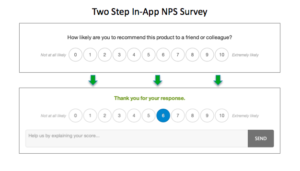Is NPS a percentage?
The NPS is not really a percentage. It is subtraction of two percentages: percentage of promoters minus percentage of detractors. It’s an index ranges from negative one hundred (-100) to one hundred (+100).
NPS calculation example
Let’s say 30% of your customers report they are likely to recommend your company, while 5% would not recommend you to their peers, your Net Promoter Score would then be: 30-5= 25
Notice that Promoters and Detractors in the Net Promoter System have a very precise definition.
A promoter is a survey respondent who gives a rating of 9 or 10 to the NPS survey question: On a scale of 0 (not at all likely) to 10 (extremely likely), how likely would you recommend our product/service to a friend or coworker?
A detractor is a survey respondent who gives a rating of 0 to 6 to the NPS survey question: On a scale of 0 (not at all likely) to 10 (extremely likely), how likely would you recommend our product/service to a friend or coworker?

A survey respondent answering the NPS survey question with a 7 or 8 is considered ‘neutral’ and won’t count towards either the detractor % or the promoter %. If every survey respondents were to rate their willingness to recommend as a 7 or 8, then the Net Promoter Score would be zero: 0-0=0.
Therefore, the NPS calculation is simple: % Promoters – % Detractors, and the survey itself is short and sweet: a single question: “On a scale of 0 (not at all likely) to 10 (extremely likely), how likely are you to recommend our product/service to a friend or coworker?”
As with any survey, the complexity is in the surveying: whom do you survey, how do you survey, where, when do you survey, how often do you survey, what do you survey?
An NPS Calculator
Many organizations look to “set and forget” NPS software to survey customers and provide a real-time calculation of Net Promoter Score. For a fast and easy NPS calculator try Microsensor by Pearl-Plaza.



